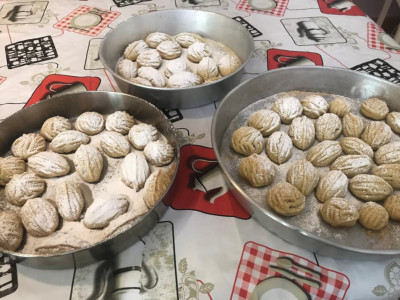Maamoul
 Maamoul is a small, traditional cookie from the Middle East, particularly Lebanon. It is usually prepared for special occasions such as Easter and Eid al-Fitr (the feast that marks the end of the Muslim fasting month of Ramadan). It is an essential part of the exchanges that take place during these religious holidays: it is offered to relatives and friends who visit each other on the feast day. In Muslim communities, it is offered at condolences so that the visitor can ask God for mercy.
Maamoul is a small, traditional cookie from the Middle East, particularly Lebanon. It is usually prepared for special occasions such as Easter and Eid al-Fitr (the feast that marks the end of the Muslim fasting month of Ramadan). It is an essential part of the exchanges that take place during these religious holidays: it is offered to relatives and friends who visit each other on the feast day. In Muslim communities, it is offered at condolences so that the visitor can ask God for mercy.
Maamoul is a shortbread pastry filled with date paste, walnut, pistachio and sometimes almond or dried figs. The dough is traditionally made with fine semolina, wheat flour, butter and orange blossom water. The dough and fillings are prepared the day before. The following day, the women usually gather around a large table to produce maamoul. Preparing maamoul is a great opportunity for relatives, neighbors and friends of different generations to meet.
To make the maamoul, women rely on traditional skills transmitted from generation to generation, creating different shapes by hand and decorating them with tongs, or using wooden maamoul molds. These decorative wooden molds measuring between 4 and 6 cm, enable to recognize the different maamouls at a glance. Generally speaking, if it’s round and conical, it’s a walnut maamoul; if it’s round but flattened, it’s a date maamoul; and if it’s elongated, it’s a pistachio maamoul. These shapes are generally respected throughout Lebanon, and the ritual of preparation is still maintained in certain families. However, maamoul recipes may differ slightly from one family to another, or from one region to another; and they may even be garnished with new fillings: loukoum (raha) or chocolate paste.
Maamoul is highly prized for its grainy texture and delicious sweet filling paste, scented with orange blossom and rose water. It can be sprinkled with powdered sugar for an extra touch of sweetness. Often enjoyed with tea or coffee, these cookies are a real delight.
Maamoul is a staple food in Lebanon, and many families prepare these cakes at home. It can also be found in bakeries, patisseries and local markets throughout the country, particularly during festive periods. Maamoul is a symbol of conviviality and sharing in Lebanon, and its preparation is often a moment of family reunion, when generations come together to prepare this delicious pastry.

